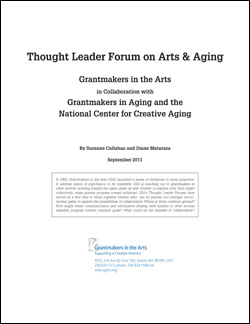Thought Leader Forum on Arts and Aging
Download:
![]() Thought Leader Forum on Arts and Aging (617Kb)
Thought Leader Forum on Arts and Aging (617Kb)
Arts and cultural organizations are continually challenged to expand the relevance of their programs beyond their immediate circle of audiences. Across the country, many forge partnerships with a host of organizations and networks in order to reach and engage new individuals. In response to well-publicized concerns about dwindling and “greying” audiences, arts and cultural organizations and funders have gravitated toward people ages eighteen to thirty-five. However, the arts and culture field has been slow to realize and prepare for a surging demographic trend, the “age wave.” People are living much longer; by the year 2030, there will be as many people over sixty-five as there are under twenty, and one in every five people in the United States will be sixty-five or older.
Increasingly, these demographics have implications for arts participation in the country. The arts field has long debated the nature of audience engagement across demographic groups, from passive observation to active participation. And now this demographic jolt has the potential to dramatically change the very nature and extent of arts engagement, reaching people in the places they will be living and in a manner in which they can participate.
At the MetLife Foundation, Barbara Dillon, director of the Health Program, and Rohit Burman, director of the Culture and Public Broadcasting Program, have identified this dilemma and initiated a response. Internally, they’ve reached across the foundation’s departments to combine resources and support research in order to equip field leaders to better prepare for what’s ahead. Externally, MetLife has collaborated with Partners for Livable Communities on a report entitled Culture Connects All: Rethinking Audiences in Times of Demographic Change, in which urban planner Maria Rosario Jackson identifies the opportunities and challenges on the horizon:
This report aptly points out that “arts and cultural organizations in search of new audiences have primarily focused on the ‘young and wireless’…one strategy for bolstering the number of tickets sold.” These organizations may be ignoring the populations that need them most and missing out on opportunities to increase their reach and resources in the aging community.

